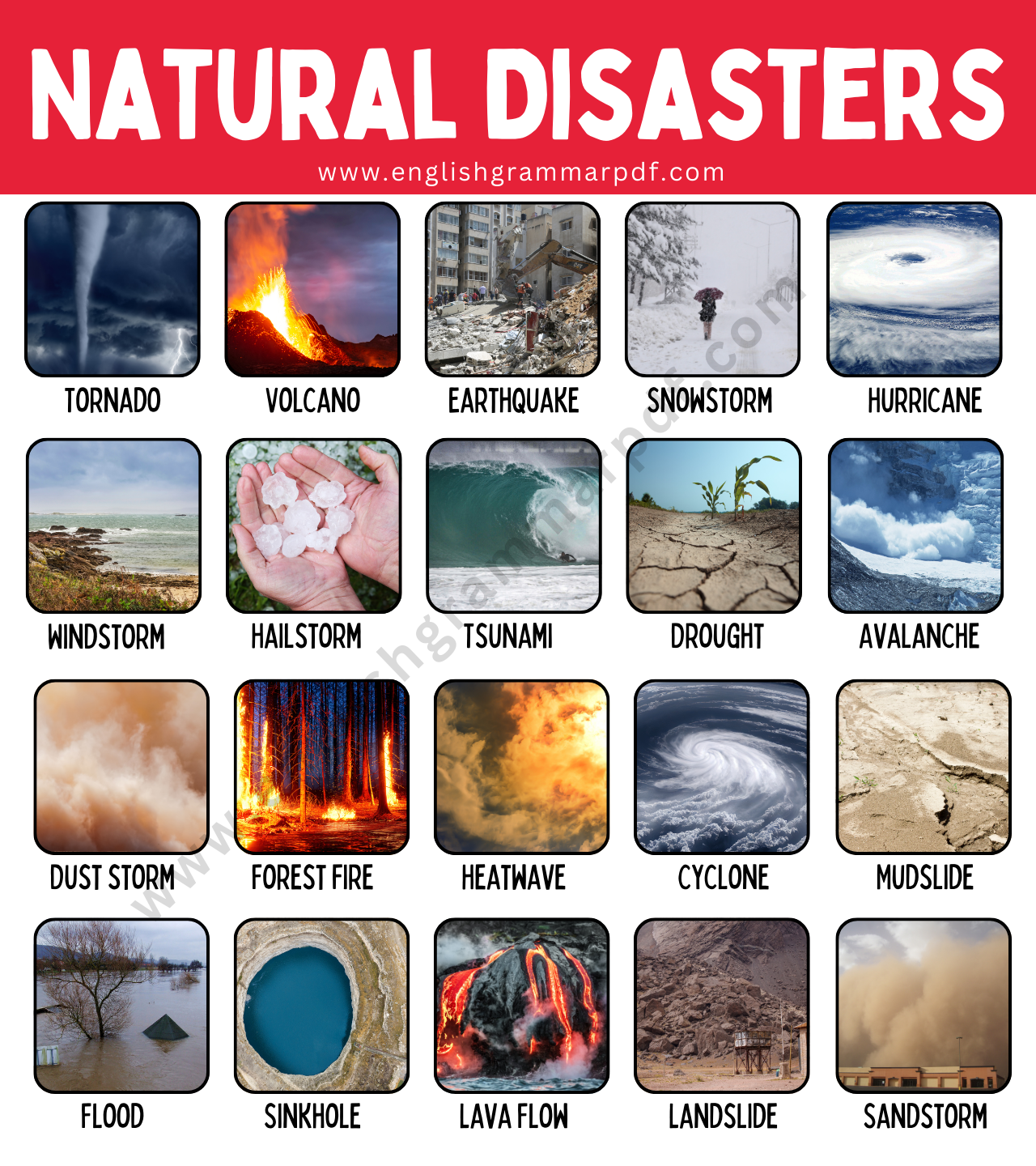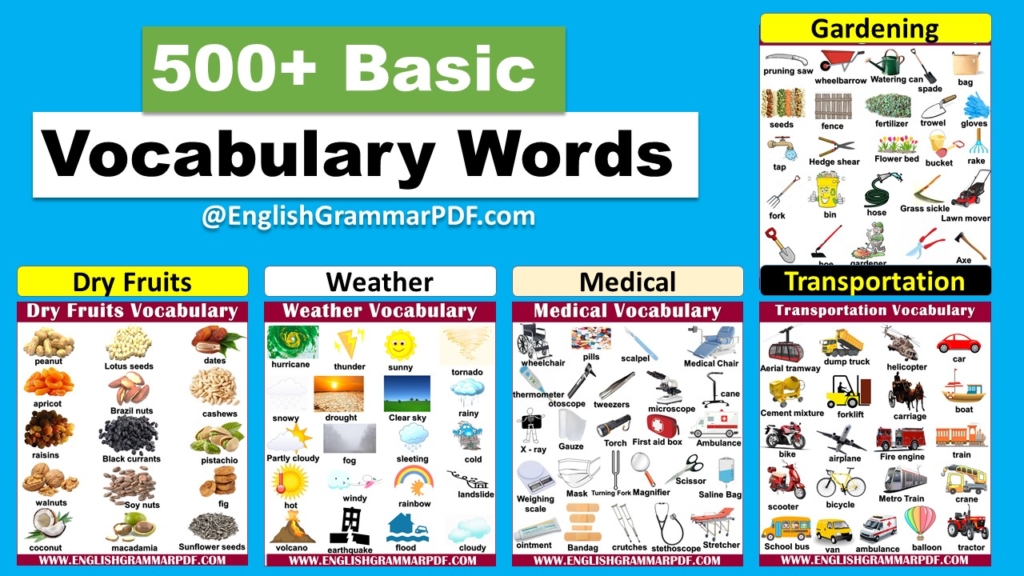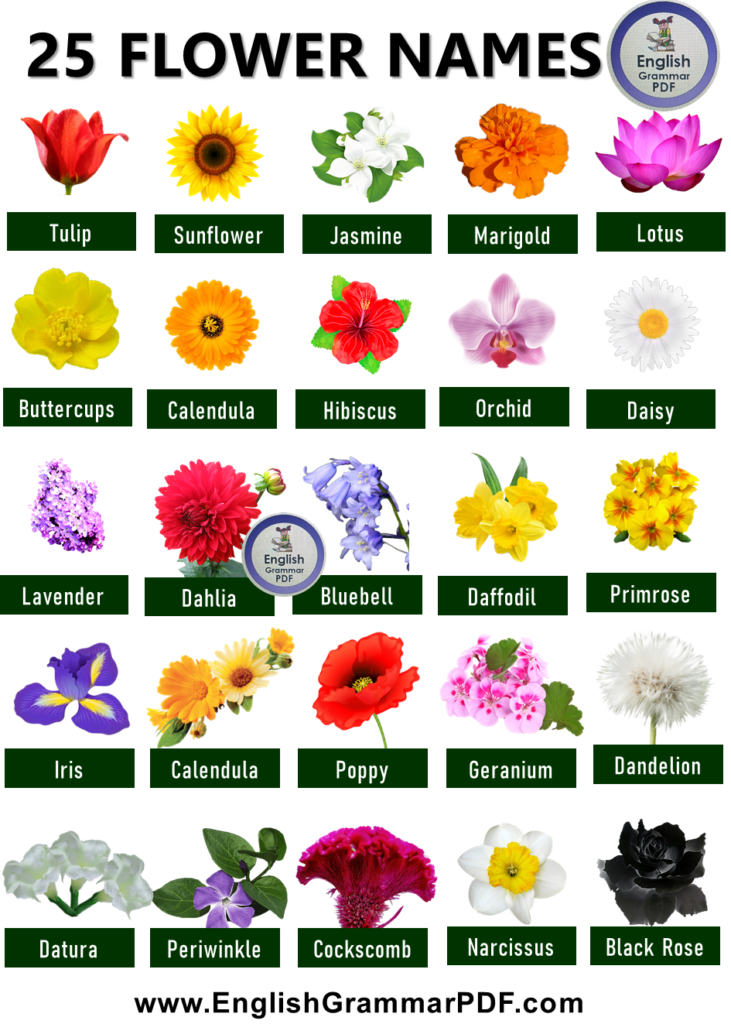Natural disasters are big, scary events caused by nature. They can hurt the land, houses, and even people. Think of them like nature’s tantrums, where the Earth shakes, water floods cities, or winds blow roofs away. These events remind us that nature is powerful and can change things in an instant. We’re going to look at different types of these disasters and show you pictures to help you understand them better.
Natural Disasters
Here is the list of natural disasters:
- Tornado
- Volcano
- Earthquake
- Snowstorm
- Hurricane
- Windstorm
- Hailstorm
- Tsunami
- Drought
- Avalanche
- Dust storm
- Forest fire
- Heatwave
- Cyclone
- Mudslide
- Thunderstorm
- Flood
- Sandstorm
- Sinkhole
- Wildfire
- Blizzard
- Cold wave
- Lightning Strike
- Typhoon
- Lava Flow
- Meteor Strike
- Acid Rain
- Solar Flare
- Severe Frost
- Glacial Lake Outburst Flood
- Tropical Storm
- Landslide
- Ice Storm
- Flash Flood
- Rockslide
- Whirlpool
- Pest Infestation
- Volcanic Ash Cloud
- Coastal Erosion
- Earth Cracks

1. Tornado
A tornado is a fast-spinning column of air that touches both the ground and a cloud above. It looks like a funnel and can move very quickly, destroying things in its path. Tornadoes can pick up cars, trees, and even houses. An example of a tornado is the one that hit Oklahoma City in 1999, causing a lot of damage.
2. Volcano
A volcano is a mountain that can explode, sending out ash, gas, and hot lava. Inside the earth, it’s very hot, and sometimes this heat can escape through cracks, creating a volcano. When a volcano erupts, like Mount Vesuvius did in ancient times, it can be very dangerous for nearby towns and cities.
3. Earthquake
An earthquake happens when the ground shakes because of energy released from inside the Earth. This can make buildings fall and roads crack. Earthquakes occur along the edges of large pieces of the Earth’s crust, called tectonic plates. A famous earthquake is the one that struck San Francisco in 1906, causing great destruction.
4. Snowstorm
A snowstorm is when a lot of snow falls quickly, sometimes with very strong winds. It can make it hard to see and travel. Snowstorms can trap people in their homes and make it very cold. The Blizzard of 1888 in the United States was a huge snowstorm that buried cities in snow.
5. Hurricane
A hurricane is a big storm with very strong winds and heavy rain that forms over warm ocean waters. It can cause flooding and destroy buildings. Hurricanes have a calm center called the “eye,” but the surrounding area is very dangerous. Hurricane Katrina in 2005 was a very destructive hurricane in the United States.
6. Windstorm
A windstorm is when very strong winds blow without any precipitation like rain or snow. These winds can knock down trees, power lines, and damage homes. A windstorm doesn’t have a specific name but can be part of other storms like hurricanes or tornadoes.
7. Hailstorm
A hailstorm is when balls of ice, called hail, fall from the sky. Hail can damage cars, crops, and windows. Hail forms inside strong thunderstorm clouds when updrafts carry raindrops upward into extremely cold areas of the atmosphere, freezing them. A severe hailstorm hit Munich, Germany, in 1984, causing extensive damage.
8. Tsunami
A tsunami is a series of large waves caused by an underwater earthquake, volcano, or landslide. Tsunamis can flood coastal areas and destroy everything in their path. The 2004 Indian Ocean tsunami was caused by a very strong underwater earthquake and affected many countries.
9. Drought
A drought is a long period without rain, causing a shortage of water. This can make it hard to grow food, and rivers and lakes can dry up. Droughts can last for months or even years. The Dust Bowl in the 1930s was a severe drought that affected the Great Plains of the United States.
10. Avalanche
An avalanche is when a mass of snow, ice, and rocks slides quickly down a mountainside. Avalanches can bury anything in their path, including people. They often happen after a heavy snowfall. In 1910, an avalanche in Wellington, Washington, buried two trains, making it one of the deadliest avalanches in US history.
11. Dust storm
A dust storm is when strong winds pick up and carry a large amount of dust, covering everything in its path. It can reduce visibility to zero, making it very dangerous to travel. The Dust Bowl era in the US included many severe dust storms that caused major ecological and agricultural damage.
12. Forest fire
A forest fire is a large, uncontrolled fire in an area with a lot of trees and plants. It can spread quickly and is hard to put out. Forest fires can be caused by lightning or human actions. The Australian bushfires in 2019-2020 were some of the most extensive and severe.
13. Heatwave
A heatwave is a period of unusually hot weather that can last for days or weeks. It can cause health problems, especially for older people and children. Heatwaves can also dry out the land and make droughts worse. The European heatwave in 2003 was one of the hottest on record.
14. Cyclone
Cyclones are huge, spinning storms that form over warm ocean waters. They can bring strong winds, heavy rain, and cause flooding. For example, when a cyclone hits a coastline, it can damage buildings and knock down trees.
15. Mudslide
A mudslide happens when a lot of mud suddenly flows down a hill or mountain. It can be caused by heavy rain or an earthquake. Houses and roads can be buried by mudslides, like the one that occurred in California, causing a lot of damage.
16. Thunderstorm
Thunderstorms are powerful storms with thunder, lightning, rain, and sometimes hail. They can happen anywhere and might lead to flooding or damage from lightning strikes. An example is a summer thunderstorm that cools the air but can also knock out power.
17. Flood
A flood happens when there is too much water in one place. This can be because of heavy rain, rivers that overflow, or seas that rise. When the water comes too fast for the ground to soak it up, it can cover roads, houses, and fields. An example of a flood is when a river overflows after days of rain, covering nearby towns.
18. Sandstorm
Sandstorms are big clouds of sand and dust. They happen in deserts when strong winds blow loose sand into the air. Sandstorms can make it very hard to see and breathe. An example is a huge cloud of sand in the Sahara Desert, making the day look like night.
19. Sinkhole
A sinkhole is a big hole that suddenly opens up in the ground. It can happen when water dissolves rock underneath, leaving a space. The ground above then falls into this space. An example of a sinkhole is when a street suddenly collapses, leaving a big hole.
20. Wildfire
Wildfires are big, uncontrolled fires that spread quickly in forests or grasslands. They can start by lightning or by people’s mistakes. Wildfires can destroy homes, animals’ homes, and large areas of land. An example is a forest fire that spreads over many miles because of dry weather and strong winds.
21. Blizzard
A blizzard is a severe snowstorm with very strong winds and lots of snow. It can make it very hard to see and travel. Blizzards can trap people in their homes and make roads unsafe. An example of a blizzard is a snowstorm that lasts for days, burying towns in snow.
22. Cold Wave
A cold wave is when the weather gets much colder than usual, very fast. It can harm plants, animals, and people who aren’t ready for the cold. An example of a cold wave is when temperatures suddenly drop below freezing, causing problems for everyone not prepared for the cold.
23. Lightning Strike
A lightning strike is when electricity from a storm hits the ground. It can be very dangerous and start fires or hurt people. Lightning strikes often during big storms with lots of thunder. An example is when a tree gets hit by lightning and catches fire during a storm.
24. Typhoon
A typhoon is a big tropical storm with very strong winds and heavy rain. It happens over warm ocean waters. Typhoons can cause floods and damage when they hit land. An example of a typhoon is a huge storm that hits an island, bringing lots of wind and rain.
25. Lava Flow
Lava flow is when hot, melted rock comes out of a volcano and moves over the ground. It can destroy anything in its path. Lava is very hot and dangerous. An example of a lava flow is when a volcano erupts, and the hot lava covers nearby villages.
26. Meteor Strike
A meteor strike happens when a space rock hits the Earth. It can make a big crater and cause a lot of damage. Most meteors burn up before hitting the ground, but some are big enough to reach the Earth. An example is when a large meteor hit Russia in 2013, causing damage and injuries.
27. Acid Rain
Acid rain is rain that is more acidic than normal because of air pollution. It can harm plants, animals, and buildings. Acid rain happens when pollution from factories and cars mixes with water in the clouds. An example is when a forest’s trees get damaged because of acid rain from nearby cities.
28. Solar Flare
A solar flare is a sudden burst of energy from the sun. It can affect communication and power on Earth. Solar flares send out a lot of radiation and can cause beautiful auroras in the sky. An example of a solar flare is when people’s radios and TVs stop working because of a burst from the sun.
29. Severe Frost
Severe frost happens when the temperature goes below freezing, and a thick layer of ice forms. It can damage crops and plants. Severe frost is especially harmful in early spring when plants are just starting to grow. An example is when a sudden frost kills many flowers in gardens.
30. Glacial Lake Outburst Flood
This flood happens when water breaks through a dam made of ice from a glacier. It can release a lot of water very quickly and be very destructive. These floods are most common in mountain areas where glaciers are found. An example is when a lake held back by a glacier suddenly floods a valley below.
31. Tropical Storm
A tropical storm is a storm with strong winds and rain that happens in tropical areas. It is not as strong as a typhoon but can still cause a lot of damage. Tropical storms can lead to floods and landslides. An example is a storm that brings heavy rain and strong winds to a coastal area, causing flooding.
32. Landslide
A landslide is when a lot of earth, rock, or debris slides down a slope. It can be caused by rain, earthquakes, or human activity. Landslides can bury houses and roads. An example of a landslide is when a hillside collapses after heavy rain, covering a village below.
33. Ice Storm
An ice storm happens when rain freezes as it hits the ground, covering everything in ice. It can cause power outages and make roads very slippery. Ice storms can break trees and power lines. An example is when a city gets coated in ice, making travel very difficult.
34. Flash Flood
A flash flood is a sudden, severe flood that happens quickly, often in just minutes or hours. It can be caused by heavy rain or when a dam breaks. Flash floods are very dangerous because they happen so fast. An example is when a desert area suddenly gets flooded after a rare heavy rain.
35. Rockslide
A rockslide is when rocks and debris slide down a slope. It can happen on mountains or cliffs and is often caused by rain or earthquakes. Rockslides can block roads and be very dangerous. An example is when rocks fall onto a highway in the mountains, blocking the road.
36. Whirlpool
A whirlpool is water spinning round and round very fast, making a kind of water hole. They can be small or very large and dangerous. Whirlpools happen in oceans, rivers, and lakes. An example of a whirlpool is when water spins near a waterfall, pulling things into the center.
37. Pest Infestation
Pest infestation is when a lot of insects or animals invade a place, causing damage. It can happen to crops, houses, or wild areas. Pests like locusts can eat all the plants in an area. An example is when locusts invade a farm, eating all the crops.
38. Volcanic Ash Cloud
A volcanic ash cloud is a cloud of ash that comes out of a volcano when it erupts. It can spread over large areas, making it hard to breathe and damaging engines. An example is when a volcano erupts, sending ash over nearby cities and causing problems for airplanes.
39. Coastal Erosion
Coastal erosion is when the land by the sea gets worn away by waves and wind. It can change beaches and cliffs and sometimes destroy homes. Coastal erosion happens slowly over time. An example is when a beach house falls into the sea because the land around it has been eroded away.
40. Earth Cracks
Earth cracks are big cracks that appear in the ground. They can happen because of earthquakes, drying land, or mining. Earth cracks can be dangerous and damage buildings and roads. An example is when cracks appear in the desert ground after a long drought, making the land unstable.


